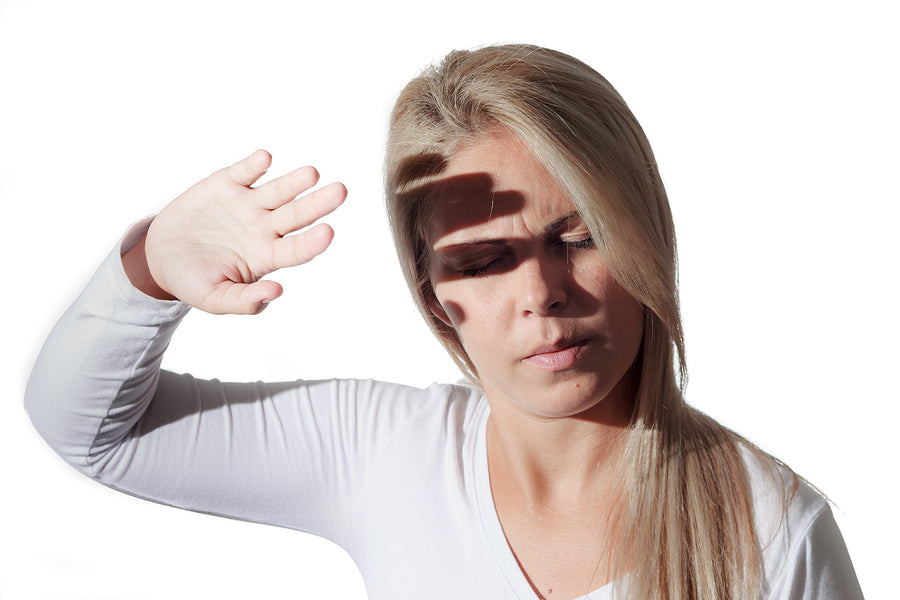If you suffer from migraine, bright lights headache might be a frequent problem for you. It may be a fact of life that under certain types of light, you’re likely to get a migraine. Unfortunately for you and many others, photophobia or light sensitivity can be a literal pain.
To make things worse, your light sensitivity may be more than a migraine trigger or something that occurs after onset. It could actually show up any time between migraine episodes, making life pretty uncomfortable. In short, bright lights and headache often go together. But light sensitivity can show up on its own at any time.
Pretty lame, isn’t it?
Science tells us that photophobia and migraine make a whopper of a combination for a lot of people. In fact, studies show that 90% of migraineurs suffer from light sensitivity. On its own, however, photophobia can be a chronic condition. It can disrupt your daily life, even without any type of headache.
No matter when it shows up — as a bright lights headache or chronic condition — photophobia is no laughing matter. But the more we learn about the causes and treatments, the more discomfort can be avoided. So let’s take a look at what we know.
The Most Irritating Light
Fluorescent, LED & Retail
As addressed on a recent Migraine Again podcast with Dr. Bradley Katz, leading neurophthalmologist at the Moran Eye Center at the University of Utah, certain types of light — not the brightness of it — are the most likely culprits of photophobia.
According to reports from sufferers, people with photophobia seem to have the most trouble with fluorescent, LED, and gas discharge lighting (like you might find in big box or home improvement stores). Perhaps surprisingly, a lot of people who are irritated by these lights have no issues with sunlight, even though the natural light on a sunny day is much brighter.
What does this tell us? When we look at fluorescent, LED, and gas discharge lighting, what they have in common isn’t brightness, but the wavelength or color of the light they generate. These types of lighting emit much stronger wavelengths of blue light than any other color. We are always learning more about the eye and its light sensitivity pathways to the brain. As we go, we’re learning that certain wavelengths of light — blue, in particular — are more likely to bother sensitive individuals than other wavelengths.

Flickering
Flickering lights can also bother some people who suffer from bright lights and headache. Some detect a mild flickering in modern fluorescent lighting. But even driving along a tree-lined street in the sunlight, or between street lamps at night can bring on a flickering effect. This causes discomfort, or a motion-type sickness for some people.
Headlights
During night driving, some photosensitive individuals feel discomfort from bright headlights from oncoming traffic or rearview mirrors. Especially bothersome are the modern blue xenon headlamps found on some cars.
What’s Safer?
Natural light tends to be the least irritating, unless you’re getting an intense reflection from windows, water, or snow. Sitting near a window at home or at work can light your environment without discomfort. But what about artificial light?
Incandescent lighting, with its burning filament, is more akin to natural sunlight. Like the sun, it emits a smoother, more balanced array of all wavelengths, rather than putting out much more blue. This may be why incandescent lights are easier to deal with for most light sensitive people.
Avoiding Discomfort of Bright Lights & Headache
The discomfort of many types of artificial lighting tempts many light sensitive people to withdraw from certain situations altogether. If bright light headaches are a problem for you, it’s easy to see why this would seem like a good idea. However, we can also see why commercial buildings use the types of light they usually do. Fluorescent, LED, and gas discharge lighting is bright, inexpensive, and energy-efficient. These types of lighting save money, and generally do their job well.
You can ask your employer about allowing you to modify the lighting in your office, and you may get some flexibility. Unfortunately, you’re unlikely to get the same accommodations from a grocery store. Yes, the lighting causes legitimate discomfort in some people, but changing it is a hassle and expense they probably aren’t up for. So, what can you do, short of banishing yourself to darkness?

Control What You Can Control
The first thing you can do is dictate the lighting choices in environments you control. You can ask for modified lighting at work. Perhaps you can shut off or unscrew fluorescent bulbs, and use incandescent desk lamps instead. You can also use blue-light filters on your computer screen, or blue-light filtering apps on your smartphone.
At home, you can avoid bright lights headaches by using only the types of light that don’t bother you. Incandescent bulbs work well for most light sensitive people, but not for everyone. LED lighting of one kind might bother you, but another kind might be fine. The key is to test out the lights in store displays to see how you react. Then, buy just one or two bulbs to bring home. That way, you can make sure they’re the right fit without spending hundreds of dollars on light bulbs.
Sadly, you simply cannot control every light you come across. So rather than hibernating to avoid discomfort, try precision-tinted lenses for light sensitivity from Axon Optics eyewear, powered by Avulux® Migraine and Light Sensitivity Lenses.
Our eyewear is convenient, affordable, and completely portable. They are specially made to block only the offending wavelengths of light. In fact, they're patented, and the only clinically proven lens for people with migraine and light sensitivity lenses. That means you can work, shop, and play while managing the impact of light on your life. Put them on anytime you’re under lighting conditions that you cannot control.
Depending on your level of sensitivity, you can order your Axon Optics eyewear with frames that offer additional peripheral protection from light. They may help block light from the sides or top of your glasses. Some even come with gaskets between the lens and frame for extra protection.
What Not to Do
According to Dr. Katz, wearing sunglasses indoors is a bad idea, as is living in darkness most of the time. Why? Because this can actually dark adapt your eyes. This means your eyes become even more sensitive when you take off your sunglasses or go out in the light.
“Regular sunglasses are necessary outdoors, but they are made to block all types of light, not just the painful kind. So the more you wear sunglasses inside or keep yourself in the dark, the more sensitive your eyes are likely to become over time,” says Dr. Katz.
Axon Optics powered by Avulux lenses block the painful light without dark adapting your eyes. They are the only clinically proven lenses that precisely filter light to help people living with migraine. Safe to wear all day, every day, our Avulux lenses can help you live your life in any type of lighting.
Summary
Yes, bright lights can cause headaches due to a high concentration of blue light, which has been shown to trigger migraine attacks. Common light-related migraine triggers are LED lights, fluorescent lights, glare, computer/TV screens, and car headlights.
If you find yourself struggling with bright lights, there are two options: avoidance and controlling your environment. Ways to control your environment include modifying lighting in your home, light filters on electronic screens, and precision-tinted migraine glasses.





